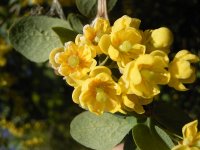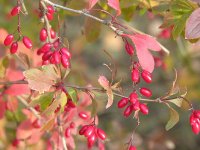Barberry common - berberis vulgaris l.
Family Barberry - Berberidaceae
Botanical characteristics. Deciduous shrub is 1.5-3 m high. It grows along forest edges, in shrub thickets, in forests, on mountain slopes, and also in culture.
Underground organs consist of thin horizontal rhizomes and a powerful main root with lateral roots. The shoots are smooth, ribbed or furrowed. Trunks and shoots are sealed with spines. Leaves alternate thin membranous, elliptical or obovate, oblong, edentate along margin, dull above and shining from below. The flowers are light yellow in axillary drooping brushes. Fruits - oblong berries, sour, from purple to dark red. Seeds are dark brown. Blossoms in April-May, fruiting from the end of July to September.
Spread. It mainly grows in the southern zone of the country: in the Caucasus, in the Crimea, it is sometimes found in the middle zone, it is widely cultivated in gardens and suburban areas.
Used parts of the plant. Medicinal raw materials are roots, root bark, shoots, leaves, flowers, fruits, seeds harvested in the usual way.
Chemical composition. Roots, bark, stems contain alkaloids: berberine, berberrubin, columbamin, palmatine, yatrorricin, berbamin, isotetradrin, oxyocortin, magnoflorin. The leaves contain carbohydrates: polysaccharides; Alkaloids of the protoberberine group, vitamins, phenolcarboxylic acids, anthocyanins, carotenoids. Fruits contain carbohydrates, pectins, organic acids, vitamins, tannins, carotenoids; Seeds - fatty oil.
Application. Roots are raw materials for obtaining berberine, which in the form of berberine-bisulfate is used in medical practice as a cholagogue, lowers arterial pressure, causes uterine contractions. Roots are part of the collection for cooking potions by Zdrenko. The root bark is a part of the preparation "Chololitin", its action is similar to berberine. Decoction of the bark and roots is used for liver tumors, stomach and throat cancer; With tuberculosis, pleurisy, febrile states; Diseases of the eyes and mouth.
Alkaloids have antibacterial activity. The bark of branches is used for medical purposes similarly to roots. The alcohol extract and the amount of alkaloids have sympathicotropic properties and are more potent than the ergot extract. The berberine-bisulfate separated from the leaves is choleretic; Tincture of the leaves causes a reduction in the smooth muscles of the uterus and narrowing of the vessels, somewhat accelerates the coagulation of the blood; It is used in obstetric and gynecological practice with atonic bleeding in the postpartum period and with subinvolution of the uterus, as well as bleeding associated with inflammatory processes. Tincture of fruits has antibacterial, hypotensive and sedative effect. In Bulgaria, fruits are used to treat diabetes, as well as with stomach spasms.
In Chinese, Mongolian and Tibetan medicine, barberry is used for diseases of the mucous membranes, with abundant mucus secretion, diseases of various organs, in the treatment of tuberculosis, as a diuretic; In Indian medicine - with scarlet fever and mental illnesses, as a laxative, antiseptic and tonic with weakness of the body; In Transbaikalia - with colds and flu as an antipyretic and diaphoretic remedy, with gastric spasms, stomach diseases and spleen diseases. In Azerbaijan, barberry preparations are used to treat diabetes mellitus. In homeopathy, the roots of barberry are used for metabolic disorders, kidney diseases, for the treatment of gout and hemorrhoids. Barberry is widely used as a vitamin and food remedy. Young leaves are a source of vitamins.
Preparation
- For broth take 20 g of root bark, chop, pour 200 ml of boiling water, insist 30 minutes, cool 10 minutes without removing from the bath, filter the warm. Take 2 tbsp. Spoon 2-3 times daily before meals.
- Tincture of the root is prepared on 70% alcohol at a rate of 1: 5. Insist 10 days. Take 40 drops per reception 2-3 times a day.
It is used in the homeopathic practice of Barbaris 3x, 3, 6. In case of violations of salt metabolism: in renal and cholelithiasis; With diseases of the joints with a sense of weakness, general weakness, pain, aggravated by movement. It is shown with some chronic digestive disorders and sexual weakness.





Comments
When commenting on, remember that the content and tone of your message can hurt the feelings of real people, show respect and tolerance to your interlocutors even if you do not share their opinion, your behavior in the conditions of freedom of expression and anonymity provided by the Internet, changes Not only virtual, but also the real world. All comments are hidden from the index, spam is controlled.